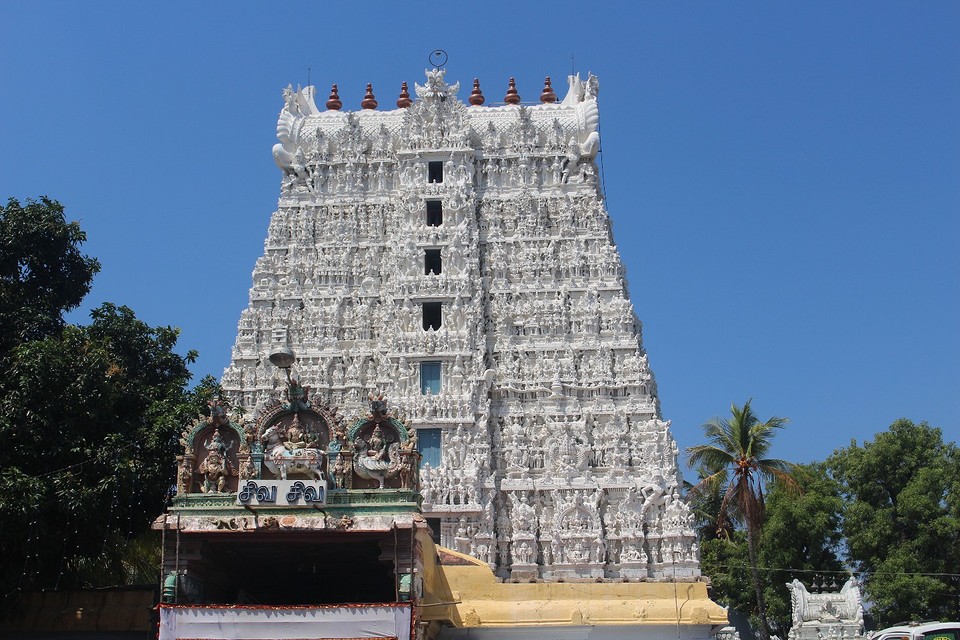Place Details: Rameshwaram, Tamil Nadu
Ramanathaswamy Temple:
The Ramanathaswamy Temple in Rameshwaram is one of the twelve Jyotirlinga temples dedicated to Lord Shiva. It holds immense religious significance for Hindus and is a major pilgrimage site.
Location:
Rameshwaram is situated on Pamban Island in the Gulf of Mannar, at the southern tip of the Indian peninsula. It is part of the Ramanathapuram district in Tamil Nadu.
Rituals and Festivals:
The Ramanathaswamy Temple is a hub of religious activities. Devotees visit to perform rituals and seek blessings, with Maha Shivaratri being a prominent festival celebrated with great devotion.
Agniteertham:
Agniteertham is a sacred beach in Rameshwaram where pilgrims take a ritual bath before entering the Ramanathaswamy Temple.
Pamban Bridge:
The Pamban Bridge connects Rameshwaram to the mainland and is a historic cantilever bridge offering stunning views.
Transportation Facilities:
-
By Air:
-
The nearest airport is Madurai International Airport.
-
Alternatively, Tuticorin Airport is also accessible.
-
-
By Train:
-
Rameswaram has its own railway station, well-connected to major cities.
-
-
By Road:
-
The town is well-connected by road, and buses and private vehicles are common modes of transportation.
-
-
Local Transportation:
-
Auto-rickshaws and cycle-rickshaws are available for local travel within Rameshwaram.
-
Ramanathaswamy Temple Timings:
-
The temple is generally open from early morning to late evening.
-
Morning rituals and darshan start early, around 4:00 AM or 5:00 AM.
-
The temple may close during the afternoon.
-
Evening aarti and darshan are part of the daily routine and may continue until 9:00 PM or later.
Travel Expenditure:
-
Transportation:
-
Consider the cost of airfare or train/bus tickets.
-
Calculate expenses for local transportation within Rameshwaram.
-
-
Accommodation:
-
Costs may vary based on the type of lodging chosen.
-
Advance booking is advisable, especially during peak seasons or festivals.
-
Food:
-
Budget for meals based on preferences, with local eateries offering budget-friendly options.
-
Temple Rituals and Offerings:
-
Include costs for any special rituals or offerings at the temple.
-
-
Miscellaneous Expenses:
-
Budget for sightseeing, shopping, or other activities.
-
Nearby Places To Visit:
-
Dhanushkodi:
-
A ghost town at the eastern tip of the island with ruins and a sacred beach.
-
-
Agniteertham:
-
The holy beach for ritual baths.
-
-
Pamban Bridge:
-
A historic bridge with scenic views.
-
-
Gandhamadhana Parvatham:
-
A hillock offering panoramic views of Rameshwaram.
-
-
Kalam National Memorial:
-
A memorial dedicated to Dr. APJ Abdul Kalam.
-
Historical and Religious Importance:
-
Religious Significance:
-
Rameshwaram is known for its association with the Ramayana and the bridge built by Lord Rama to Lanka.
-
The Ramanathaswamy Temple is considered sacred in Hindu mythology.
-
-
Mythological Connections:
-
Rameshwaram is believed to be the place where Lord Rama built the bridge to rescue Sita.
-
-
Architectural Significance:
-
The Ramanathaswamy Temple showcases intricate Dravidian architecture.
-
-
Cultural Heritage:
-
The town has a rich cultural heritage, with festivals and traditions reflecting its historical roots.
-
Interesting Facts About Rameshwaram:
-
Rama Setu:
-
The bridge built by Lord Rama to Lanka is also known as Adam’s Bridge.
-
-
Dr. APJ Abdul Kalam:
-
Former President of India, Dr. APJ Abdul Kalam, was born in Rameshwaram.
-
-
Floating Stones:
-
Some stones used in the construction of the Ramanathaswamy Temple are believed to float in water.
-
-
Maha Shivaratri Celebrations:
-
Maha Shivaratri is celebrated with grandeur at the Ramanathaswamy Temple, attracting devotees.
-
Best Time To Visit:
-
Winter (October to February):
-
Pleasant weather for sightseeing.
-
-
Spring (March to May):
-
Moderate temperatures with lush greenery.
-
-
Summer (June to September):
-
Warm temperatures with occasional rainfall.
-
-
Maha Shivaratri:
-
Plan visits around Maha Shivaratri for vibrant celebrations at the temple.
-
Enter your email to get the Latest Updated Exploring News and Topics






